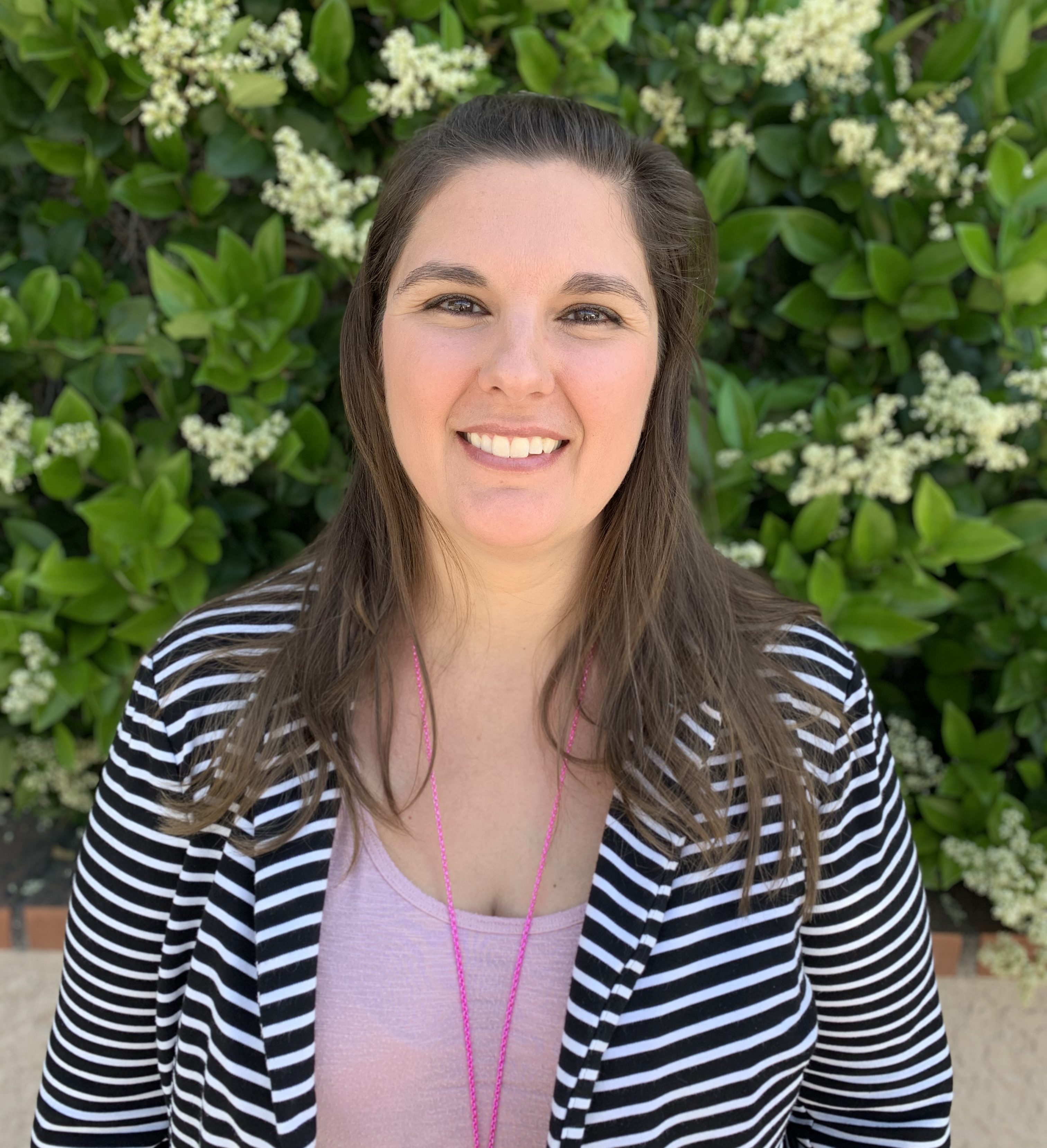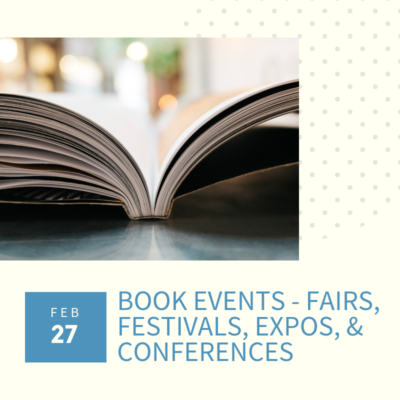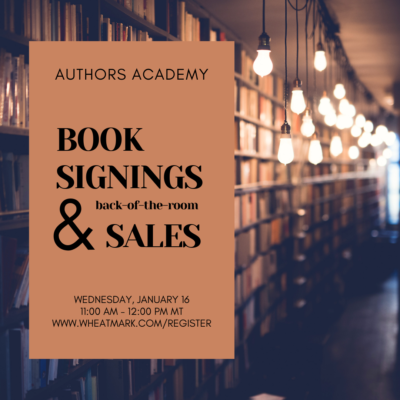Where to Get Your Book Reviewed
 In these constantly changing times, it’s critical to stay updated on the places and strategies you can use to get more reviews.
In these constantly changing times, it’s critical to stay updated on the places and strategies you can use to get more reviews.
For next week’s Authors Academy presentation, we’ll lay out all of the steps you’ll need to take when reaching out to reviewers.
Join us next Wednesday at 11 AM in Arizona (10 AM PST, 1 PM EST) to learn more about:
• How to find a reviewer that’s a good fit for your book
• Using your location, genre, and book topics to improve your chances
• How to get more Amazon reviews
• and more!
Your host for the call is Wheatmark’s publishing consultant, Tia Lewis, who has worked in editorial both in the NYC publishing scene and self-publishing scene. In addition to her publishing experience, Tia has worked as a social media marketer and video editor.
Don’t miss out on this exciting opportunity — just click on the following link now to register:
https://www.wheatmark.com/register
When you register at the link above, we’ll send you the log-in info for the presentation immediately.
Online Advertising Explained

Advertising is a great way to reach new audiences, but the online space can be intimidating with its nearly limitless options.
For this Authors Academy presentation, we broke down where you should advertise online, how you should do it, and how long you should invest.
Join the Authors Academy to learn more about:
- The best websites to place an ad
- How to make an advertisement appealing
- Advertising strategies for authors
- and more!
To register for the next webinar, go to wheatmark.com/register.
Book Festivals vs. Writing Conferences
 We talk a lot about how to reach new audiences online—but what about networking and marketing your book offline?
We talk a lot about how to reach new audiences online—but what about networking and marketing your book offline?
For next week’s Authors Academy presentation, we’re taking a deep dive into book festivals and writers conferences, and how they can help you.
Join us next Wednesday at 11 AM in Arizona (10 AM PST, 1 PM EST) to learn more about:
- Which author events to consider attending
- How to make the most of a book festival
- Networking at writers conferences
- and more!
Your host for the call is Wheatmark’s publishing consultant, Tia Lewis, who has worked in editorial both in the NYC publishing scene and self-publishing scene. In addition to her publishing experience, Tia has worked as a social media marketer and video editor.
Don’t miss out on this exciting opportunity — just click on the following link now to register:
How to Get Booked on a Podcast (and More!)
 Although it can be intimidating, reaching out to podcasters, radio shows, newspapers, and book reviewers is the best way to introduce your book to wider audiences.
Although it can be intimidating, reaching out to podcasters, radio shows, newspapers, and book reviewers is the best way to introduce your book to wider audiences.
For today’s Authors Academy presentation, we laid out all of the steps you need to take to start collaborating with other content creators.
Authors Academy members can watch the recording to learn:
- How to find the right creators to contact
- What to offer and what to ask for
- How to keep the marketing momentum going
- and more!
Your host for the call is Wheatmark’s publishing consultant, Tia Lewis, who has worked in editorial both in the NYC publishing scene and self-publishing scene. In addition to her publishing experience, Tia has worked as a social media marketer and video editor.
To make sure you don’t miss our next Authors Academy webinar, click the link below to register:
How to Think Like a Book Marketer

Writing a book is a feat on its own, but learning how to market that book is a whole other adventure.
For next week’s Authors Academy presentation, we’ll explore how marketers look at product sales and how you can use that same marketing knowledge to grow your book’s audience.
Join us next Wednesday at 11 AM in Arizona (11 AM PST, 2 PM EST) to learn more about:
- How to target your audience
- Spreading your book to new locations
- Holding events and talks about your book
- and more!
Your host for the call is Wheatmark’s publishing consultant, Tia Lewis, who has worked in editorial both in the NYC publishing scene and self-publishing scene. In addition to her publishing experience, Tia has worked as a social media marketer and video editor.
Don’t miss out on this exciting opportunity — just click on the following link now to register:
Summer Social Series: Instagram
 Join us next Wednesday for the third and final installment of our Summer Social Series: Instagram: The Art of Image-Driven Content.
Join us next Wednesday for the third and final installment of our Summer Social Series: Instagram: The Art of Image-Driven Content.
Now one of the most popular social media platforms available, the photo-sharing app has come a long way from its humble beginnings. So why should you “do it for the ‘gram?’”
Because a whopping 1 billion people use Instagram every month! Sixty percent of users (that’s 600+ million people) seek out and discover new products on Instagram, and more than 200 million users visit at least one business profile every day.
If you have something to sell, this personal and business platform is a great opportunity for you to reach those customers.
Here’s what you’ll discover when you join us for this presentation: (more…)
Behind the Scenes of NYC Publishing

Join us next Wednesday as we peel back the curtain on this exclusive world with Anne Spieth, an experienced professional from the traditional publishing arena who recently joined Wheatmark, Inc. as Publishing Consultant, and who is also the newest Senior Faculty member of the Authors Academy!
For the past 10 years, Anne has been working at two of the Big Five New York publishers: in publicity at Minotaur Books/St. Martin’s Press (Macmillan), then in marketing and design for Macmillan Audio, and finally in marketing for Simon & Schuster/Atria.
Anne rejoined Macmillan’s adult Library Marketing division in 2013, where she did online marketing, book title presentations, and exhibited at major industry conferences.
During her time in NY, Anne worked with many New York Times bestselling and acclaimed authors, including Jodi Picoult, Lisa Scottoline, Louise Penny, Jenny Lawson, John Lescroart, Rainbow Rowell, Sophie Littlefield, Stephanie Garber, Roshani Chokshi, Linda Castillo, Katherine Center, Shobha Rao, and many, many more.
For one hour next week, Anne will share her NYC publishing experiences and answer your most burning questions about traditional publishing!
Here’s how you can get your question answered during the call: comment on our Facebook page or send us an email and pose a question or questions for Anne.
She’ll select the best questions to answer live on the call first – and will answer all of them, time permitting.
If you’ve ever wondered how things work at the traditional houses, don’t miss this valuable opportunity! Click the link below now to register for the call:
https://www.wheatmark.com/
When you register at the link above, we’ll send you the log-in info for the call immediately.
Book Events – Fairs, Festivals, Expos, & Conferences
 Join us tomorrow, February 27th, for our next Authors Academy presentation, “Book Events: Fairs, Festivals, Expos, & Conferences” with Wheatmark’s own Mindy Burnett.
Join us tomorrow, February 27th, for our next Authors Academy presentation, “Book Events: Fairs, Festivals, Expos, & Conferences” with Wheatmark’s own Mindy Burnett.
Once again our topic is inspired by the upcoming Tucson Festival of Books, which takes place Saturday and Sunday, March 2nd & 3rd (a week earlier than in past years.)
Here at Wheatmark, we field questions all the time about which events are worth attending and which aren’t — and this is our chance to provide some insight.
Here’s what you’ll discover during this workshop:
- The different types of book events
- What the main purpose of each type is
- Which ones you should attend, and which you can safely skip
- How to make the most of the events you do attend
Mindy Burnett is helming our booth presence once again at this year’s TFoB, so she’s got some great insight into the opportunities (and the potential pitfalls) events like the TFoB provide.
You don’t want to miss this unique opportunity to learn more about how these events work — just click on the following link now to register:
https://www.wheatmark.com/
When you register at the link above, we’ll send you the log-in info for the call immediately.
And if you have a question to ask about book events, please send an email to support@wheatmark.com, and we’ll be glad to address it during the call.
You don’t want to miss this!
Book Signings and Back-of-the-Room Sales
 You may know that here at the Authors Academy, we’re strong advocates of using the Web to build your author platform.
You may know that here at the Authors Academy, we’re strong advocates of using the Web to build your author platform.
But that doesn’t mean you shouldn’t strive to build an audience face-to-face, too: either locally, regionally, nationally, or beyond.
The truth is, there’s nothing quite like the thrill of meeting your readers (and gaining new fans) in person!
And, of course — in addition to being a great way to build buzz for your projects — book events can be just plain fun.
Join us next week as we tackle “Book Signings and Back-of-the-Room Sales” with one of our favorite Tucson-based publicists, Lynn Wiese Sneyd.
Lynn Wiese Sneyd coordinates national, regional and local publicity campaigns for authors of non-fiction and fiction books. She’s scheduled author appearances on major television networks (ABC, NBC, CBS, FOX and PBS affiliates), Sirius Satellite, syndicated AM/FM radio shows, and internet podcasts.
In addition, she’s worked with print media, securing interviews and feature articles in magazines like Woman’s Day and Prevention Magazine, and daily newspapers.
Lynn works exclusively with authors to promote their books and also collaborates with publishers, as she has done with Tarcher/Penguin, Prometheus Books, HCI Communications, Carolina Academic Press, Paradigm Publishers, and others.
Lynn has also worked as a community relations manager for Barnes & Noble Booksellers, where she scheduled and hosted author events, sponsored book groups and workshops, and initiated partnerships with community organizations to promote literacy and support the arts.
Join us next week as Lynn reveals how to kick your next event up a notch or two — or three!
You’ll discover:
- Why you should never hold just a book signing
- Why you should hold events at which you sign books
- What the best places are for such events
- How to approach event venues
- What to do at events
- How to publicize your events
- How to handle book sales at your events
- and more!
Don’t miss out on the opportunity to do a deep dive with us on this critical topic — just click on the following link now to register:
https://www.wheatmark.com/
When you register at the link above, we’ll send you the log-in info for the call immediately.
And if you have a question to ask about book signings, please send an email to support@wheatmark.com, and we’ll be glad to address it during the call.
You don’t want to miss this!
Ghostwriting for the Novice

Lori Conser with Wynn Thompson
I’ve dreamed of writing a book since I was a skinny little sixth grader in 1975. That was the year I fell madly in love with reading.
But now, forty-three years later, I still haven’t accomplished that dream.
Over the last fourteen years, I’ve worked at Wheatmark and watched author after author fulfill their dreams of seeing their written words turned into books for publication. It’s been an inspiration.
And I’ve realized that dreams don’t just get handed to you. You have to pursue them and diligently work at them.
So when Wynn Thompson, an elder in my church, told me he was struggling to write his autobiography, I realized that this could be my chance. Wynn has an amazing story, and I’ve always wanted to try my hand at ghostwriting. So I took the plunge and volunteered to ghostwrite it for him. He was elated. This was an answer to prayer, he said.
And thus it began—a novice’s adventures in ghostwriting.
I knew from my past experiences as a newspaper reporter that the first thing I needed to do was learn his full story. So I downloaded a recording app onto my phone and started interviewing Wynn in two-hour sessions once a week. Because Wynn is quite a talker, it took several months for me to get his whole story—and we chased more than a few rabbits. Transcribing all these recordings to notes on paper was brutal—each transcribing session taking twice as long as each interview.
But once this was done, I read through all the transcribed material and knew I had the makings of a good story. But how would I organize it? What would I keep? What would I let go? At first I thought about ordering the plot in some cool way, like using a scene from later in his life to propel him back to the past, then to the present, then to the past again…
But let’s face it, tenses can get super tricky when you write like that, and I didn’t want to make this more complicated than I could handle. So I decided to keep it simple…at least for the first draft.
Next, I organized a rough outline of all my chapters, and the characters and settings that I was going to use for the first part of the book. This is called story boarding, and I’m still working through my own version of it. I found an app that helps called Trello, which has simplified the process.
The trickiest part in this whole process has been finding enough time to write. Because I work full time and my job requires that I sit at a computer all day, it’s nearly impossible for me to even look at a computer when I get home. So I carved out an hour each morning—from 5:30 to 6:30 —that can only be used for writing Wynn’s book. It’s been working pretty well so far. Morning is definitely the best time for me to write because my mind is fresh. True, having a two-hour block of time would be even better. But that would mean compromising on other morning commitments—something I’m not willing to do.
So now I’m in the writing phase of the project—finally! Every time I complete a chapter, I send it to Wynn with questions like, “What did your house look like?” or “Can you think of a particular scene that shows how your mom and dad interacted with each other?”
Wynn is eager to fill in the details, and we’ve become quite the team. He also modifies each area where my imagination goes haywire, then sends the updated version back to me for more rewriting and editing.
The best part about this whole project is that Wynn’s counting on me. His excitement and expectations help to keep me steady and faithful; I don’t want to let him down.
And God willing, step by step, we will see this through to publication.
Thanks for the inspiration!
